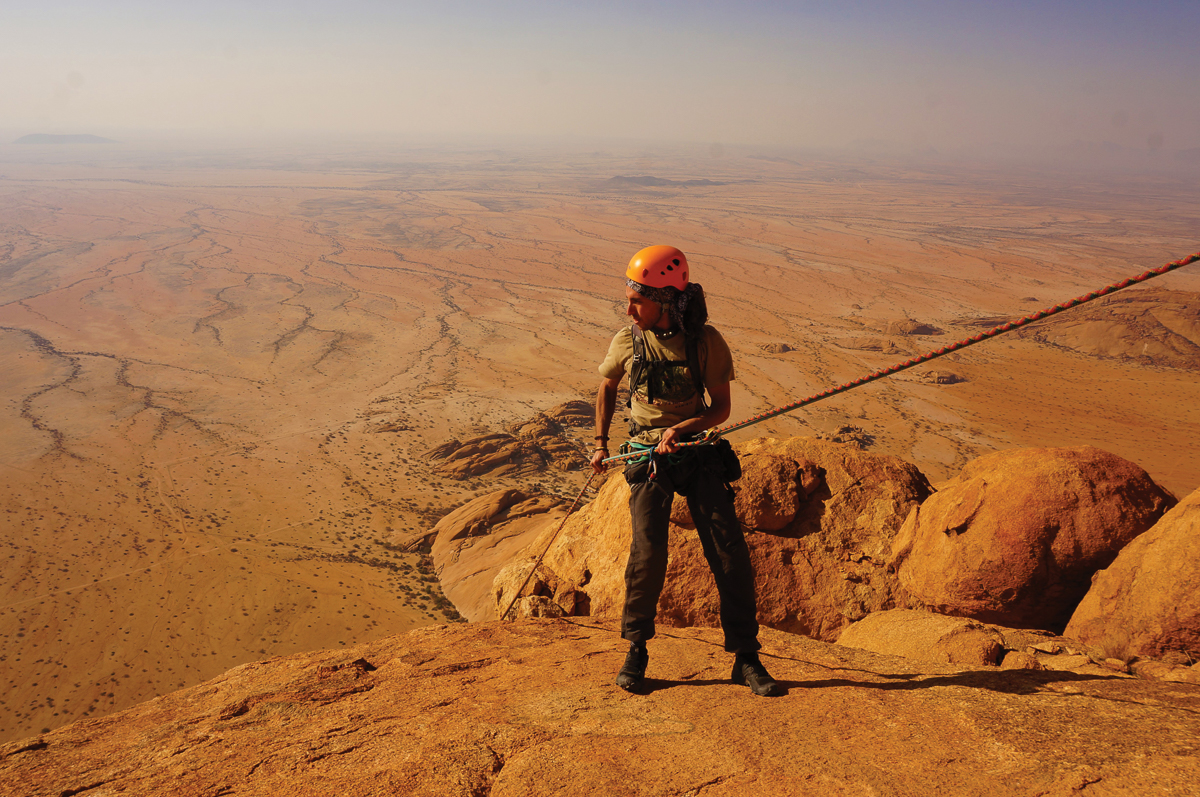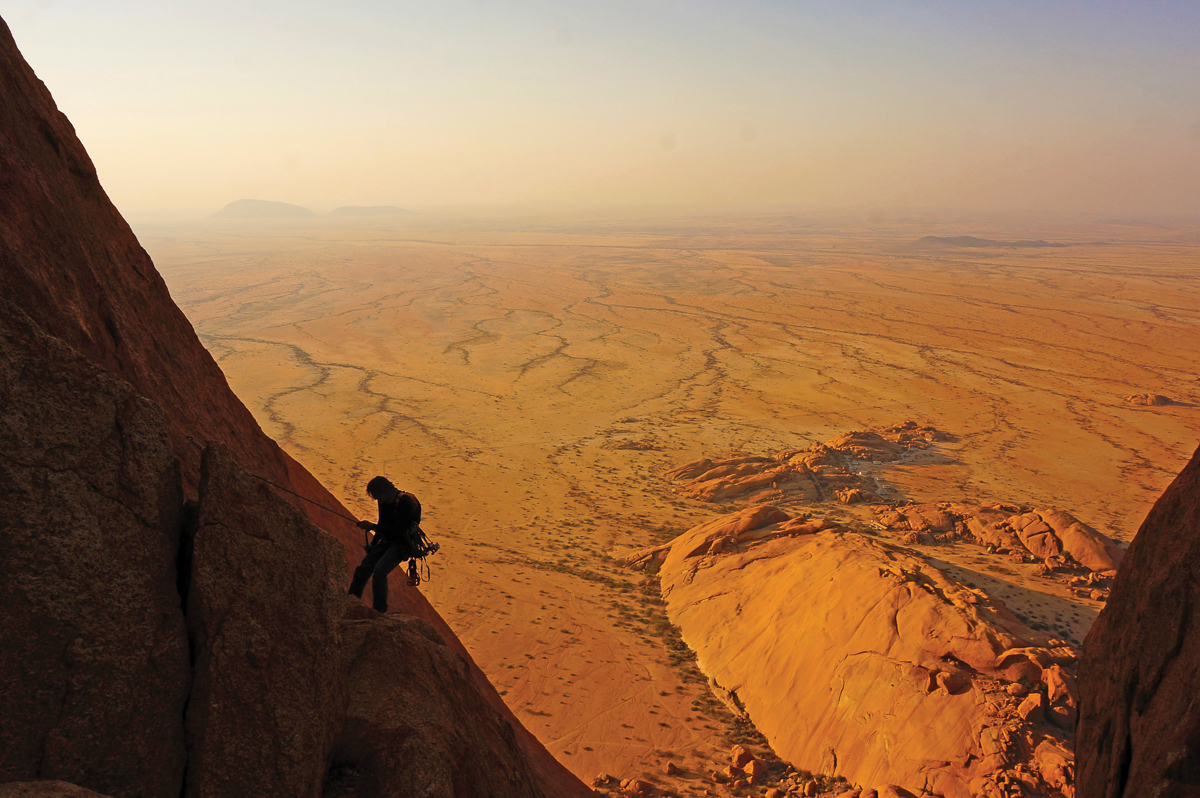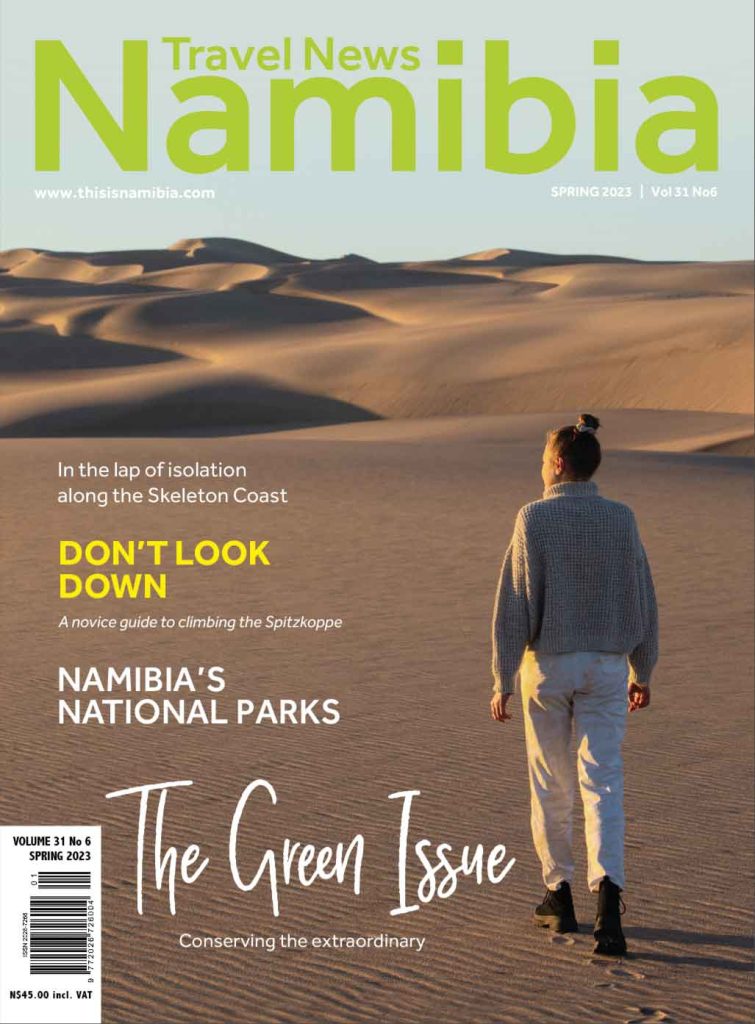

Don’t look down: A novice guide to climbing the Spitzkoppe
I am no climber, not self or otherwise proclaimed, and what follows should not be seen as a definitive guide to the Spitzkoppe. I have also never been to the Matterhorn, the comparison inspired by a simple google search of “Spitzkoppe”, so I can in no way attest to the accuracy of the statement “Namibia’s Matterhorn”. In spite of this, it has an adventurous ring to it – climber or not. In June this year a group of friends and I managed to summit that great granite beast known as the Spitzkoppe, and here’s hoping that qualifies me to tell the tale of summiting it.
Text & Photographs Zan Le Roux
From the Spring 2023 issue
The epic began some months earlier when a friend of mine added me to the WhatsApp group “Spitzkoppe Summit”. The name said it all, the plan was to summit the Spitzkoppe. Simple as the plan was, we had to get a few things in order before setting off – assemble a team, beg, borrow or steal the necessary equipment, learn how to climb and finally go climb that mountain.
The motley six, as I’ve named us, included: Luke Brinkman (the founder of the Whatsapp group), Joe Lichtman (medical officer), Josh Lichtman (head chef), Søren Jensen (chief abseiler), Freddy Setzkorn (the only experienced climber) and myself (photographer). Our gear consisted of harnesses, tight fitting climbing shoes, helmets, chalk bags, ropes, slings, prusiks, quickdraws, cams, nuts, bugs, grigris and an array of other devices, each with their own equally non-descript name in climbing vernacular. Training had all of us joining the local climbing gym, Urban Friction, where we would spend a few evenings each week familiarising ourselves with the gear and building up fitness before heading to a local bar to discuss strategy.
In what felt like in a flash, the months of training had passed and it was time to head to the mountain. On a Friday morning we scurried around Windhoek collecting the last few pieces of borrowed gear before setting off towards the Spitzkoppe. After the mandatory stop at Wilhelmstal farm stall for coffee and biltong, and Usakos for refreshments, we turned right onto the familiar dirt road towards Spitzkoppe, and the magnitude of what we were undertaking started to set in.
The Spitzkoppe, a set of granite inselbergs, rises approximately 700 metres out of the surrounding Namib Desert and tops out at a height of 1728 metres above sea level. At 120 million years old with solid granite faces running up its sides, the mountain is impressive to say the least. Hans and Else Wongtschowski and Johannes de Villiers Graaff were the first to climb the mountain in 1946, probably wearing veldskoene and using manilla rope (the type we see in pirate movies). Now, 77 years later, we too wanted to leave our mark in history and make our way up the red mountain.
On arrival on Friday afternoon we immediately set off to one of the easier routes where we could do a bit of practice climbing and get “a feel of the rock”. After our first collective outdoor climb we made our way back to our campsite, which we shared with a horned adder and a genet, and busied ourselves with repacking gear and filling water bottles for the following day. As with most Namibian gatherings, supper was prepared on the fire and paired with a few Tafels. Sitting in the firelight, with the Spitzkoppe rising into the night sky above us, we all felt privileged to be there. Beer and tea flowed throughout the night and conversations drifted from history to philosophy to religion. We differed on why we had been born into our lives and what we should be doing with our time on this earth, but we were all equally in awe of this journey, and eager to live it well. Importantly, we had all come to the conclusion that in that particular time and place, the correct thing to do was to climb the mountain we had set out to climb. As the fire and the conversation died down, we each in turn settled down under the stars and slipped into sleep lulled by the sound of barking geckos and excited for the awaiting adventure.
Saturday morning had us up and packing long before sunrise. After a quick breakfast we gathered what we needed and drove to the starting point at the base of the mountain. As the first light of dawn appeared above the eastern horizon, with the stars still visible in the sky, we started our ascent of the Spitzkoppe. Following the “normal route”, marked by rock cairns and a faint footpath, we slowly made our way up the mountain. With coils of climbing rope wrapped around our bodies and climbing gear jingling in our packs we definitely looked the part and before we knew it, we were thoroughly into “the scramble”.
This first section of the route takes you up a few slabs and gullies, over, under and around a few boulders and could loosely be called hiking. Two chimneys need to be wriggled up, the last one being particularly tight, and generally there is no need to tie into a rope for this section. The last chimney has you passing through a narrow crack in the rock in almost complete darkness and bags need to be passed along overhead as you won’t fit through with one on your back. Emerging from the belly of the beast, we reached a point where we had to abseil down roughly ten metres and make our way along a ledge to the start of “the climb”.
A smooth, near vertical granite slab bars the way to the top and rather obviously indicates the start of the climb. If I had any doubts about whether it was necessary to tie into a rope up until this point, these doubts are quickly replaced by a desire to be secured to the mountain by as many means as possible. Freddy leads the way, effortlessly climbing up the slab and out of sight placing protection as he goes along. Freddy is followed by Luke, then Søren, Josh and Joe, and I bring up the rear. In this way we slowly move up the mountain, each tied to the other and equally invested in the safety of all of us. The climb is broken up into five sections known as pitches and varying from 25 to 50 metres in length. At the end of each pitch there is an anchor place where everyone can tie in, have a drink of water, and discuss the next section. These little gatherings become a safe haven and are the goal of each pitch. Out on the open face you are alone with the rock, systematically placing hand over hand and foot over foot, your friends are out of sight and the wind blows their words of encouragement away before they can reach you. One rope runs up to safety and one rope runs down to the next soul coming up. At the end of the pitch your friends sit waiting, smiling nervously, there is shelter and banter and strength for the next section.
The climb continues in this fashion until you reach the last pitch. At this point the trees on the landscape below are reduced to specks and it feels like the rock you are sitting on could slide off the mountain at any moment. If in this situation you do not experience a fear of heights, I think it is safe to say that you are fearless. Regardless, for those of you who like me enjoy spending your time on ground level with two feet firmly planted, I suggest that you do not look down and simply focus on the rock in front of you and the task quite literally at hand. This last section has us squeezing up a short chimney, breathing heavily and, in the truest sense of the word, following a trail of blood where the first few of our party have wedged their bare legs against the sharp granite crystals. Emerging from the chimney you crawl out onto a slab dropping off for hundreds of metres in all directions and slowly make your way up to the summit.
Almost suddenly, after a gruelling climb, we were on top, with the desert stretching as far as the eye can see in a 360 degree panorama. The dry riverbeds lined with shrubs are scrawled across the landscape like patterns on a carpet, and in the distance you can see the Brandberg to the north and the Erongo Mountains to the east. The summit is marked by an unassuming pile of rocks and a metal box containing the summit book. We scribbled our names into it and enjoyed paging through the history. Many familiar names were found on those pages. Friends, family and the who is who of the Namibian climbing scene. Everyone writes about the challenge of getting to the top, the awe of reaching the summit and signs off with their name. They, too, thought it was simply necessary to climb the mountain and did it, all of them searching for their own taste of heaven.
As the ecstasy of reaching the top wore off, we were faced with the next challenge: getting down. Climbing down the mountain involves a series of abseils down sheer and often overhanging faces from one anchor point to the next. As each in turn stepped over the edge and into the abyss, we quickly realised that this is not for the faint-hearted and that abseiling is not as easy as Tom Cruise made it look in Mission Impossible. The first abseil has you descending nearly 60 metres onto a sheer face where you clip into an anchor and dangle off the side of the mountain while setting up the next abseil. With nowhere to stand, never mind sit, this would not be a good place to spend the night. In spite of this, after a few hair-raising moments and heated exchanges we all reached the bottom of the abseils safely and were happy to be on our feet again. From the bottom of the abseils we walked down on the same trail we had come up earlier in the day and made our way back to the car. The sun started to set when we arrived at the car, exhausted yet full of energy and relieved to be back in familiar territory. The story continues with the usual post-achievement celebrations of cold beer, meat and the excited telling and retelling of the day’s events.
Our friends and families back in Windhoek have heard the stories multiple times. Each time we tell it we seem to have missed an important detail that needs to be reiterated. I was so enthralled with the achievement that I agreed to write an article about it. I am grateful for the opportunity to have climbed the Spitzkoppe. I feel it was an excellent way to spend my time. Experiences like these, shared with friends, are what I enjoy, and I am privileged to live in a country that affords me these occasions in more ways than I can name. As for what to do with one’s time on earth, I can highly recommend visiting the Spitzkoppe. If you have the urge to climb it, then climb it. If not – then don’t. The mountain was there long before us and will be there long after we are gone.

More to explore


Lüderitz Nest Hotel: A New Era of Elegance on Namibia’s Shores





